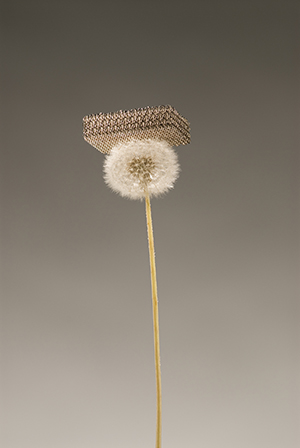New Hollow-Strut Nanoporous Graphite Frameworks Break World’s Lowest Density Solid Record
The record for the world’s lightest solid material appears to have been broken yet again, and this time an advanced form of carbon takes the cake!
For those of you who missed the recent hubbub in the realm of ultralow density solids, last November, Schaedler and colleagues at HRL Laboratories, LLC (formerly Hughes Research Laboratories) published an article in the journal Science describing an approach for making nickel “microlattices” with densities as low as 0.9 mg/cc. The Guinness Book of World Records currently recognizes a silica aerogel with a density of 1 mg/cc made by Lawrence Livermore National Laboratory as the world’s lowest density solid, so obviously this is an exciting claim!
Well move over metallic microlattices–researchers at the Hamburg University of Technology and the University of Kiel report a new kind of ultralow density hollow-strut graphite frameworks called “aerographite” with densities as low as 0.2 mg/cc–egad, that’s a vanishing 200 micrograms per cubic centimeter! If you could scale such a material to the size of a person weighing, say, 84 kg (185 lbs), that person-sized piece of aerographite would only weigh 16.8 g (a little over half an ounce)! The full details of the discovery are available in their June 12, 2012 article in the journal Advanced Materials.
(Before we go any further, a brief note to those of you who are wondering if these materials magically float in air given that the standard density of air is a relatively leviathanic 1.225 mg/cc–the densities reported for these materials are the bulk densities of the lattice material sans air, that is, a hypothetical version of the material with the air sucked out. As a result, both metallic microlattices and aerographite, like classical ultralow density aerogels, don’t float in air unless you do some parlor tricks such as backfilling the material with helium and dropping it into an aquarium filled with a dense gas such as xenon.)
Both metallic microlattices and the newly reported aerographite are elastic even in their lowest density forms, meaning they can squish and rebound, and have impressive strength properties and good electrical conductivity. It’s important to note that not all metallic microlattices or aerographite materials are this low in density, and in fact the most useful materials are probably going to be heavier than these record-setting versions.
Thus it appears a new class of ultralow density solids, hollow-strut nanoporous frameworks (we’re calling them “HNFs”), has emerged and is demonstrating new ways of making really, really low-density materials!
For those of you interested in making aerographite yourself, we’re publishing a beta version of the experimental details under the Make section here on Aerogel.org (beta because we haven’t tested it ourselves yet).

SEM images of graphite microlattice ("aerographite") made by CVD deposition of carbon onto a ZnO powder template while the ZnO was reduced and vaporized (Hamburg University of Technology and University of Kiel)

Metallic microlattice made from nickel-phorphorous alloy on a dandelion, no longer the world's lightest solid (HRL Laboratories)

Prof. Steiner, You certainly anticipated me with: “As a result, both metallic microlattices and aerographite, like classical ultralow density aerogels, don’t float in air unless you do some parlor tricks such as backfilling the material with helium and dropping it into an aquarium filled with a dense gas such as xenon.” However, a regular latex balloon with a volume of an average human being lifts far more than 1/2 oz.
Aerogels are recognised for their insulating properties. I have not seen any reference to the insulating properties for this new substance. Is there any information on this?